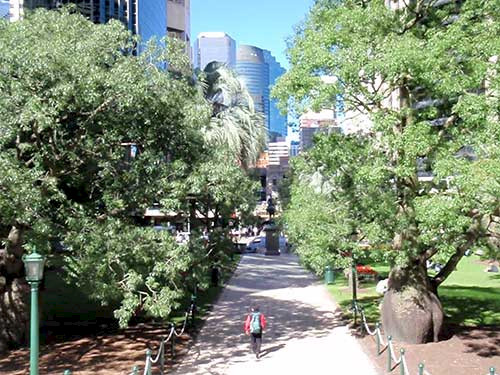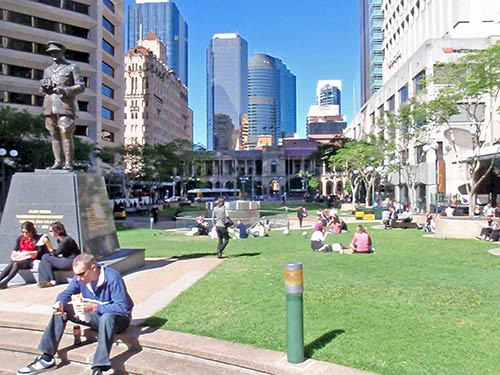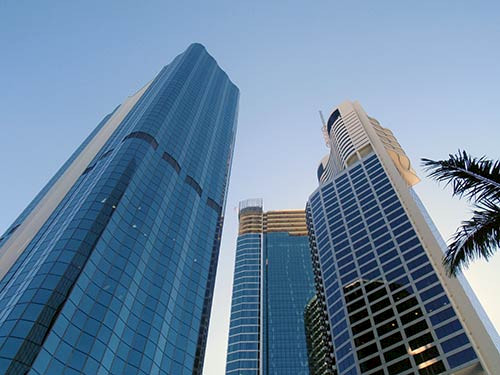Walking tour of Brisbane (Part 2): Financial district, riverside and botanic gardens
Bill Dennison ·Back to ANZAC Square, the walk down the stairs (from the bottom, 19 stairs, a landing, and 18 stairs to commemorate the end of WWI in 1918) and through the walk lined with baobab (bottle) trees from South Africa to symbolize the Boer Wars. In addition, Middle East date palms are in the square to commemorate ANZAC's role in the Middle East in both WWI and WWII. There are many statues in the square, depicting different wars.

The next square on the way to the Post Office is Post Office Square with a large food court underneath. The General Post Office (GPO) is the official center of Brisbane and often distances around the city are given as distance to GPO. The post office was built in 1872, and you can walk straight through to Elizabeth Street. Crossing Elizabeth Street, you are at the front entrance of Cathedral of St. Stephen, a beautiful gothic Catholic church. Construction of the cathedral began in 1864. One of the stained glass windows is the 'Mayne' window, depicting the family who donated the land for the University of Queensland, documented in a very readable book, "The Mayne Inheritance" by Rosamond Siemon. The land that the Cathedral is on is a quiet corner of a bustling city, surrounded by the skyscrapers of Brisbane's financial district.


You can walk through the Cathedral grounds to Charlotte Street and walk over to Eagle Street Pier, with shops and restaurants. There is a great view of the Story Bridge, built in 1940, connecting Kangaroo Point with the city. The Story Bridge is named after J.D. story, a man responsible for helping create the University of Queensland. Following the Brisbane River to the left, you can visit Customs House, standing guard over the Brisbane River from when ships sailed all the way up the river to the city. Customs House is leased by the University of Queensland and was completed in 1889. It has a copper roof, meeting rooms and has a restaurant overlooking the river.
Returning to the Eagle Street Pier, you can walk along the river until you reach the City Botanic Gardens, established in 1855. The Botanic Gardens were flooded in January 2011, and in various previous floods. The stranding of the navy ship Paluma in 1893 with a subsequent refloating in a second flood has been described previously. There is a sculpture in the Botanic Garden from the World Expo '88, which was held on South Bank across the river and was a 'Coming of Age' event for Brisbane. There is a nice City Gardens Cafe in what was the Curator's Cottage which has some historic photos of the gardens. Following along the water, there is a mangrove boardwalk which allows you to view the Kangaroo Point Cliffs across the river where much of the rock used in the early construction of Brisbane was gathered, originally by convicts. You can often spot rock climbers on the face of the cliff practicing their skills.

Passing behind the large open air amphitheater, the Queensland University of Technology campus begins. Weaving your way through the QUT buildings, you can find Old Government House, built in 1862 and housing the first 11 Governors of Queensland, until a larger house 'Fernberg' was constructed in the suburb of Paddington. In 1909, Old Government House was given to the University of Queensland, which was originally located at this site before moving upriver in the 1930's to its current location in the suburb of St. Lucia. QUT now operates Old Government House. Old Government House was the site of the creation of an Australian culinary icon, the lamington. Created by a Government House cook for the Governor, Lord Lamington, the lamington is a sponge cake completely iced with chocolate and sprinkled with dried coconut which is desiccation resistant.
This is the second of three posts on the Brisbane Walking Tour
The other two posts are:
1. Walking tour of Brisbane (Part 1): Parklands, City Hall and ANZAC
3. Walking tour of Brisbane (Part 3): Parliament, World War II and beyond
About the author
Bill Dennison

Dr. Bill Dennison is a Professor of Marine Science and Vice President for Science Application at the University of Maryland Center for Environmental Science.

